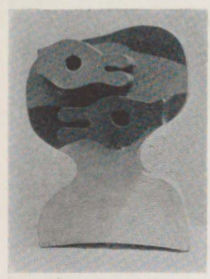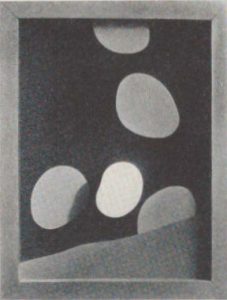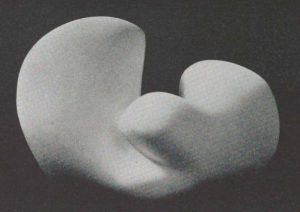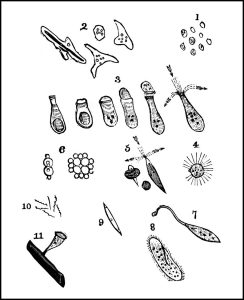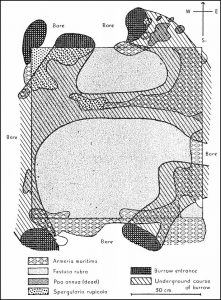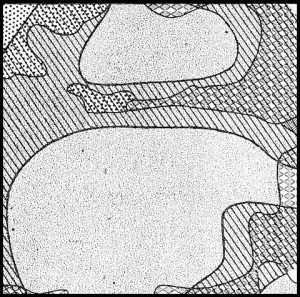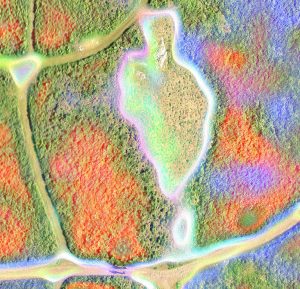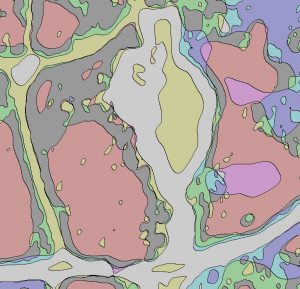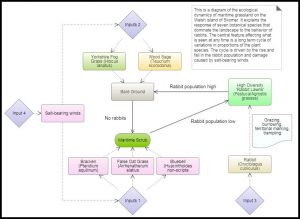Art meets science
Fig 1 Fishing float decorated with biomorphs, The Massim District of New Guinea, Alfred Cory Haddon
For those seeking a cultural bridge between science, art, and environment the concept of biomorphism may be taken as an important crossing point. The term “biomorph” was coined by English anthropologist Alfred Cort Haddon in 1895 with respect to designs derived from animate sources. It was applied to modernist art by English critic Geoffrey Grigson in 1934 and subsequently used by Alfred H. Barr in the context of his 1936 exhibition ‘Cubism and Abstract Art.
Alfred Cort Haddon was born on 24 May 1855, near London, the elder son of John Haddon, the head of a firm of typefounders and printers. He attended lectures at King’s College London and taught zoology and geology at a girls’ school in Dover, before entering Christ’s College, Cambridge in 1875. At Cambridge he studied zoology and was appointed as Demonstrator in Zoology at Cambridge in 1882. For a time he studied marine biology in Naples. In 1888 he led an expedition to the Torres Strait Islands, where they spent eight months investigating marine zoology. This visit led to his interest in the native culture of the region. He was particularly fascinated by the rapid disappearance of local customs and ceremonies and decided to make collections of domestic artefacts and filmed local customs before they were obliterated through the impact of modernity. Haddon was convinced that the hundreds of art objects collected had to be saved from almost certain destruction by the zealous Christian missionaries intent on obliterating the religious traditions and ceremonies of the native islanders. Film footage of ceremonial dances was also collected. It was during the collection of domestic objects that Haddon applied the term biomorph to abstract designs reminiscent of biological forms and used them to classify the native decorative art. (Fig 1 ).
Alfred Barr as the first director of the Museum of Modern Art in New York was one of the most influential forces in the development of popular attitudes toward abstract art. His groundbreaking exhibition was key to establishing the pedigree for modern art, a narrative that continues to shape the Museum’s presentation of modernism to this day. In the introduction to the catalogue, Barr declared that the day’s most adventurous artists “had grown bored with painting facts. By a common and powerful impulse they were driven to abandon the imitation of natural appearance.” To demonstrate the breadth of this modernist impulse toward abstraction, Barr assembled a wide-ranging exhibition of nearly 400 works of painting, drawing, printmaking, sculpture, architecture, furniture, theatre design, and typography. He also drew up a now-famous mindmap of the origins and influences of modern art that was reproduced on the catalogue’s dust jacket.
In the catalogue to the exhibition he addresses the emergence of biomorphism with reference to the development of the work of Hans Arp, which he regards as ‘simple in form and reticent both in spirit and subject matter’
“In the Surrealist tradition he is the puritan. In 1915, between periods of Munich Blue Rider Expressionism and Zurich Dadaism, he made collage compositions of almost geometrical purity (fig. 2). His Dada reliefs of which the Head (fig. 3) is a late example are built up of stratified sections of jigsawn, brightly painted wooden planking, like greatly enlarged units of a picture puzzle. His recent reliefs are of extreme simplicity, the cut-out shapes confined to a single level or stratum and severely framed in a rectangle. Often the relief shapes are mingled with painted shapes as in the Relief (fig. 4). Recently Arp has turned from stratified relief to sculpture in the round. His Human concretion (fig. 5) is a kind of sculptural protoplasm, half organic, half the water-worn white stone. In his concretions he was partly anticipated by an extraordinary work of Vantongerloo, the Composition within a sphere done in 1917 (fig. 6). Vantongerloo, a member of the severely rectilinear Stijl group, never again returned to such a hiomorphic form. Arp had done his collages in squares just before 1911 and never again returned to geometric form. The Arp “shape,” a soft, irregular, curving silhouette half-way between a circle and the object represented, appears again and again in the work of Miro, Tanguy, Calder, Moore and many lesser men”.
In the 1930’s biomrphism was very much in the air. In his polemical introduction to modern painting and sculpture, Art Now (1933), the British critic Herbert Read identified two ‘methods’, which he felt best described the approaches to art taken by contemporary artists. The first of these was an ‘empirical’ approach, which aimed to reproduce appearances. For Read, such dumb fidelity to surface appearances rendered the artist as little more than a slave to ‘the physiological mechanism of his sight’, and represented an aesthetic dead end.1 The second method – and in his opinion, the most productive – he labelled ‘scientific’. This approach required the artist to interrogate the structural nature of objects, in effect, playing the role of a scientist. The artist, Read wrote, ‘realises that the outward appearance of objects depends on their inner structure: he becomes a geologist, to study the formation of rocks; a botanist, to study the forms of vegetation; an anatomist, to study the play of muscles, and the framework of bones’.2
Fig 2 Composition, Hans Arp, 1915
Fig 3 Head, Hans Arap, 1924
Fig 4 Relief, Hans Arp, 1930
Fig 5 Human Concretion, Hans Arp, 1935
Fig 6 Construction within a sphere, Vantongeloo, 1917
Another artist who played a similar role in the break with realism was Paul Klee. Klee was fundamentally a transcendentalist who believed that the material world was only one among many realities open to human awareness. His use of design, pattern, colour, and miniature sign systems all speak to his efforts to employ art as a window onto that philosophical principle. Painting a canvas was a route to showcase the expression of this inner world (Fig 7).
Fig 7 Stage Landscape, Paul Klee, 1922
Geoffrey Grigson was born at the vicarage in Pelynt, a village near Looe in Cornwall. He had a scrambling country childhood that furnished him with a fingertip knowledge of the countryside. His childhood in rural Cornwall had a significant influence on his poetry and writing in later life. As a boy, his love of things of nature (plants, bones and stones) was sparked at the house of family friends at nearby Polperro who were painters and amateur naturalists.
Gregson’s poem ‘Incident of Wolves and Water’ may be regarded as a biomorphic expression in words of humankind’s extermination of wildness and the loss of spirituality to express things of the heart related to the common biological heritage of men, wolves and pigs..
GEOFFREY GRIGSON
INCIDENT OF WOLVES AND WATER
Two men saw two long wolves, low, cross
From the extensive forest which no more
Exists and go into the also now vanished church
Ruined, by an unhinged door.
Two men saw on their hind legs on the earth floor
These same wolves lap from its pillared bowl
Stale holy water as if (they thought) beasts
Of the devil as well needed medicament for the soul.
No more than this incident of wolves and water
Is recalled of that church whose footing grates a plough,
No yob of piety mentions that the same bowl unpillared
Affords stale water in a near farmyard to fat pigs now.
Artworks that conveyed a sense of vitality – such as sculptures by Constantin Brancusi, Hans Arp and Moore – were discussed by Grigson in biological terms, as abstract ciphers of vital energies or microscopical forms: ‘It is Brancusi whose polished unicellular forms have been the basis for such different figures, more complex, more ‘impure’, as those of Mr Henry Moore’, he wrote in 1935.39 Yet while the fluid, protoplasmic forms of Arp and other biomorphic modernists evoked what Alfred Barr, director of the Museum of Modern Art in New York, would characterise as ‘the silhouette of an amoeba’,40 it was Moore’s swollen, pullulating shapes in wood and stone that – in Grigson’s eyes at least – most fully testified to biology’s influence on modernist art.41 ‘When I look at [Moore’s] carvings’, he wrote in 1943, ‘I sometimes have to reflect that so much of our visual experience of the anatomical details and microscopical forms of life comes to us, not direct, but through the biologist’.42
A poet by profession, Grigson founded the literary review New Verse in 1933 and, in the pages of the modernist art magazine Axis, formulated the term ‘biomorphism’ to describe the sort of organic, semi-abstracted forms favoured by Moore and some other contemporary artists.34 Drawing upon the nineteenth-century anthropology of Alfred Court Haddon and the biologistic criticism of the German art historian, Wilhelm Worringer, he coined the term to describe artworks that were neither representational nor wholly abstract but rather appeared to owe their origins, symbolically as much as, or more than, visually, to living things.35 In a couple of essays published in 1935, Grigson spelt out the aesthetic implications of the biomorphic idiom:
They are [artworks] in which an organic-geometric tension is very well obtained. Many of their forms are almost certainly ‘degraded’, as orthodox anthropologists would say, from organic forms which came nearer to nature. Some forms are further from any originals, and those have been described as ‘biomorphic’, which is no bad term for the paintings of Miro, Hélion, Erni and others, to distinguish them from the modern geometric abstractions and from rigid Surrealism.36
Within this critical framework Grigson left no doubt that it was Moore who most closely met his biomorphic ideals:
Product of the multiform inventive artist, abstraction-surrealism nearly in control; of a constructor of images between the conscious and the unconscious and between what we perceive and what we project emotionally into the objects of our world; of the one English sculptor of large, imaginative power, of which he is almost master; the biomorphist producing viable work, with all the technique he requires.37
The view that “art is imitation (representation)” had been replaced by the theory that art is expression. Instead of reflecting states of the external world, art is held to reflect the inner state of the artist. For example, Henry Moore, said he sometimes began a drawing with no conscious aim but only the wish to use pencil on paper and make tones, lines, and shapes.
The most important biomorphist of his day was Henry Moore and Gregson discussed biology’s centrality to Moore’s practice in his 1943 monograph on the sculptor. New images of microscopic life and theories of biological development impacted profoundly upon Moore’s practice, had led to him adopting in the 1930s a biomorphic sculptural idiom that echoed the forms of living nature.
‘Biology must be acknowledged’, Gregson pleaded, ‘as a wellspring of inspiration for the contemporary artist and nowhere was this more evident than in Moore’s turgescent, fluid shapes. These ‘may be related to a breast, or a pear, or a bone, or a hill … But they might also relate to the curves of a human embryo, to an ovary, a sac, or to a single-celled primitive organism. Revealed by anatomy or seen with a microscope, such things are included now in our visual knowledge’.33
Collectively, these minute living things are now defined as microorganisms associated with the human body as a microbiome.
Fig 8 Two Forms, Henry Moore, 1934
Visually, Moore’s scupture bore all the hallmarks of a biologist’s awareness of nature’s microscopical structures. Artworks such as the amoebic Two Forms of 1934 (fig.8) powerfully convey the impression of swollen, cellular forms, gently distended by the dynamic flux and flow of internal fluids. The protuberant Composition 1932 (fig.5) correspondingly recalls the bulging asymmetry of microorganisms – as revealed in photomicrograph of protozoa and gives iconographic credence to Grigson’s claim that ‘[Moore] is interested in the round, solid shapes into which life builds itself’.57 While the appellation ‘biomorphic’ could refer to natural form in the widest possible sense – encompassing objects as diverse as, nuggets of bone and the shapes of animals – it nevertheless relied upon the findings of biology to articulate fully the range of meanings to which it was subject.38.
Constellations
A constellation in cosmology is a group of stars that are considered to form meaningful patterns in the celestial sphere, typically representing animals, mythological people, gods or creatures of the imagination ( Fig 9 ).
Fig 9 Costellation of Orion
In astronomy and navigation, the celestial sphere is an abstract sphere, with an arbitrarily large radius, that is concentric to Earth. All objects in the observer’s sky can be conceived as projected upon the inner surface of the celestial sphere, as if it were the underside of a dome or a hemispherical screen. Similarly, a constellation in biology is a group of organisms that are considered to form meaningful patterns in the biosphere. The biosphere is the layer of planet Earth where life exists. This layer ranges from heights of up to ten kilometres above sea level, used by some birds in flight, to depths of the ocean such as the Puerto Rico trench, at more than 8 kilometres deep. These are the extremes. In general the layer of the Earth containing life is thin: the upper atmosphere has little oxygen and very low temperatures, while ocean depths greater than 1000 m are dark and cold. In fact, it has been said that the biosphere is like the peel in relation to the size of an apple.
The celestial sphere is a practical tool for spherical astronomy, allowing astronomers to plot positions of stars. The biosphere is also a practical tool that allows biogeographers to plot the positions of plants and their associated animals. For the purposes of research the biosphere is broken down into smaller units. For example, a biome is a geographical area related to a climatic zone that is very large in size. Each biome has certain groups of animals and plants that are present within it. They are able to thrive there due to their ability to adapt in that particular type of environment. The smallest functional units of the biosphere have been defined as microcosms, little worlds or worlds in miniature as opposed to biomes which are macrosoms representative of greater worlds.
But more than this it is through the concept of constellations that we observe we are part of something greater. Imagine a constellation in the sky – a grouping of stars where each star has an invisible string of energy connecting one to another and to Earth’s biosphere. In our aliveness on Earth, we, and all living earthly beings, have our origins in a common system of cosmic evolution and are tethered to past starbursts in which stars and all life forms are as one. We can see that the systems creating stars and producing the structure of bacteria are governed by the same fundamental processes. We can detect the link between the hottest fusion reactions in gamma bursters and the essential metabolic reactions which give rise to, and sustain, life.
In a biological sense, depicting systemic constellations is a method of ecosystems analysis for revealing and re-aligning hidden links within groups of tightly bonded species. Like the study of stellar constellations, detecting ecological constellations it is a visual process for revealing the hidden dynamics between life forms. Since the origins of humankind, the physical environment has been profoundly shaped by the countless ways people make, modify, and interpret the places they inhabit or use. Conversely the environment has always shaped the material possibilities through which people can order their existence.This reductionist approach can be taken to the level of human families. For example, ‘Systemic Family Constellations’ describes a form of group psychotherapy that addresses current day to day problems of individuals at their source, in their family’s past; ‘Systemic Botanical Constellations’ is a form of grouping plants according to the visual patterns they make in order to understand their place in the biosphere and their relationships with humankind.
Constellations in art
In the early 1930s, Jean Arp developed the principle of the “constellation,” employing it in both his writings and artworks. As applied to poetry, the principle involved using a fixed group of words and focusing on the various ways of combining them, a technique that he compared to “the inconceivable multiplicity with which nature arranges a flower species in a field.” In making his Constellation reliefs, Arp would first identify a theme or set—for example, five white biomorphic shapes and two smaller black ones on a white ground—and then recombine these elements into different configurations. The Guggenheim Museum’s work is the last of three versions that Arp composed on this theme. His work, like Joan Miró’s, engaged Surrealism at the level of process, for he used automatist strategies to get beyond the constrictions of rational thought. Jean Arp sought to devise an abstract art that would represent a truer indication of reality than representational art, because the way in which it would be created would echo the ways in which nature itself creates. He was using the artistic concept of constellation to investigate the environment as both a material and imaginary field through which social and cultural relations are represented and constituted.
Constellation According to the Laws of Chance c.1930 is a small rectangular painted wooden relief by French artist Jean (Hans) Arp (Fig 10). Eight monochrome biomorphic forms have been painted or placed onto the surface of a white painted board. These include three white wooden ovoid forms that sit in low relief casting shadows when under light. They are arranged among five black forms which have been painted directly onto the white background. Three of the black shapes are clustered in the centre but extend towards, and in some cases touch, the white forms, while two others seem to be either entering or leaving the composition, pushed into the lower left corner and top of the frame respectively. The white wooden frame both enhances and extends the composition, mirroring the white relief shapes within it.
Fig 10 Constellations, Hans Arp, c1930
It is likely that this relief was produced in Meudon, near Paris, in the studio to which Arp had moved in 1928. The white wooden forms were ordered from a craftsman and subsequently placed by the artist alongside the black shapes he had painted. It is unclear in which order the forms were added but it is evident that Arp determined the composition.
This relief shows Arp’s preoccupation with abstracted biomorphic forms inspired by constellations of natural forms such as stars and clouds, and his attempts to develop what he referred to in 1957 as an ‘object language’ based on a small number of similar shapes (quoted in von Asten 2012, p.86). He referred to such forms as ‘cosmic shapes’ and is quoted in a posthumous publication of 1972 stating that ‘the forms that I created between 1927 and 1948 and that I called cosmic forms were vast forms meant to englobe a multitude of forms such as: the egg, the planetary orbit, the bud, the human head, the breast, the sea shell… I constellated these forms “according to the laws of chance”’ (quoted in von Asten 2012, p.57).
However, In 1983 the collector Pierre Bruguière recalled how Arp, from 1930 onwards, often moved wooden shapes around in his reliefs before deciding on their definitive form, so that random placement was not involved (Robertson 2006, p.156). Art historian Eric Robertson has suggested that Arp’s measured approach to the construction of his reliefs, combined with their ‘high degree of finish’, may seem ‘incongruous’ with the word ‘chance’ in many of their titles (Robertson 2006, p.156). However, the element of chance was manifest both in Arp’s rearrangements of the reliefs, which indicate that he did not have a premeditated plan, and also in the making of the white forms themselves: Arp reportedly gave only ambiguous instructions to the craftsman so as to encourage free interpretation.
The black and white cell-like shapes of Constellation According to the Laws of Chance express Arp’s deep-seated interest not in replicating the precise forms of nature, but in creating art based on the generative power of nature, like ‘fruit that grows in man, like a fruit on a plant or a child in its mother’s womb’, as Arp stated in 1931 (quoted in Anna Moszynska, Abstract Art, London 1990, p.113). The organic forms in this image coupled with Arp’s tendency to reposition objects indicate this desire to develop abstract art organically through the process of making.
In 1955 Arp described how black and white shapes could ‘equal writing’ (quoted in Robertson 2006, p.150). Robertson has emphasised the dominance of these colours in Arp’s work of the 1930s and 1940s but has pointed out that the ‘spatial distribution’ of forms within Constellation According to the Laws of Chance is ‘more complex’ than in most reliefs:
The forms continue to designate separate spatial realms, but the similarity of their shapes suggests not so much a tension as a relationship of complementarity in the balancing of opposites … The physical proximity of some of the white relief shapes and the black forms, whose edges occasionally touch, suggests objects of indeterminate scale moving and intersecting through three-dimensional space, an interpretation that Arp’s choice of title, ‘constellation’, consciously invites.
‘Constellation According to the Laws of Chance’ belongs to a body of work titled ‘Constellations’ that Arp had likely begun to produce in 1928. Early examples, such as ‘Constellation 1928’ (Arp Museum Bahnhof Rolandseck, Remagen), often show Arp experimenting with white wooden shapes on a white background. He continued to develop the dominant themes of this piece throughout the 1930s in his wooden reliefs such as ‘Constellation with Five White Forms and Two Black, Variation III 1932’ (Solomon R. Guggenheim Museum, New York) and papiers déchirés including According to the Laws of Chance 1933 (Tate T05005). At the time of the production of ‘Constellation According to the Laws of Chance’ Arp was closely associated with dada and surrealism, both of which fostered an interest in the disruptive possibilities of chance operations as well as the flux and movement of biomorphic forms. Arp’s wooden reliefs also influenced artists such as Henry Moore and Joan Miró.
In 1940 and ’41, he began his well known series of 22 Constellations, which consist of black dots representing stars on a white ground, using gouache and thinned oil on paper. These are very intricate works, with every part of the canvas activated. The carefully placed dots create a ‘jumping’ or ‘dancing’ sense of movement, even a “connect the dots” feeling. However, Miro’s work tends toward more of a cosmic awareness – these are stars, rather than just abstracted dots (painted poetry). The importance of his graphic work, continuous renewal and enrichment of his style show the high value which the artist attached to this medium of expression. Miro uses black ink with a range of values and refined tones, reaching wild and playful effects. With elements derived from Catalan traditional art and a spatiality, Miro gave his objects and symbols a proper life as subjects of stories from other worldly microcosms – the ideal reflection of a world longed for by the artist and framed in the context of the independence movement in his native Catalonia. This is in line with a prevailing idea that art’s core social and cultural function is as a mechanism for transformation. Three routes for artists to achieve transormation of society have been put forward by Sheila Dickinson:
- through empowering community (Complex Movements’ Beware of the Dandelions),
- by laying bare the strange configurations of power for the sake of everyman (Rosten Woo’s Vendor Power!),
- or by working within the existing halls of power to make them more humane and responsive to their constituents (Reggie Prim and Mankwe Ndosi’s project Tenant Voices in the Regulatory Services Department of the City of Minneapolis).
Constellations in science
Biomorphist art focuses on the visual power of a nonrepresentational form or pattern that resembles a living organism, in whole or part. This is a cultural view of the visual impact of the living world, which brings biomorphism into contact with ecology.
The imaging interface between biological science and European art appeared with Antony van Leeuwenhoek, 1632–1723. He was a Dutch student of natural history and maker of microscopes. He assembled over 200 instruments, some of which magnified objects several hundred times. With these microscopes he discovered the presence of creatures so tiny that they were invisible to the naked eye. He called these tiny living organisms “animalcules” (Fig 11).
“While I was talking to an old man (who leads a sober life, and never drinks brandy or tobacco, and very seldom any wine) my eye fell upon his teeth, which were all coated over; so I asked him when he had last cleaned his mouth? And I got for an answer that he’d never washed his mouth in all his life … I took some of the matter that was lodged between and against his teeth, and mixing it with his own spit, and also with fair water (in which there were no animalcules), I found an unbelievably great company of living animalcules, a-swimming more nimbly than any I had ever seen up to this time.”
– Antonie van Leeuwenhoek, Letter 39, September 17, 1683
Fig 11 Drawings of animalicules, van Leeuwenhoek
In the 1920s and 1930s the proliferation of photomicrographic imagery led to frequent comparisons between modernist sculpture and biological forms. In his photo-album of magnified natural structures, ‘World Beneath the Microscope (1935)’, W. Watson Baker accompanied the photograph of a sea-urchin shell, shot in extreme close-up, with the caption: ‘The modern sculptor must envy the massiveness of form, the grandeur of contour, of this small shell, whose dovetailing makes a strange and interesting pattern’.53
Similarly, in an essay – published in Apollo in 1930 – the Scottish documentary film-maker, John Grierson, provocatively suggested that the ‘organic’ qualities of modernist sculpture stemmed from the influence of microcinematography on the optical unconscious:
“It comes from a quickened consciousness of organic life which I am apt to think is the special stock-in-trade of a new generation. It may be that cinema has done something to open our eyes in this respect, with its power of revealing the constructions of plant life, animal life, and all life together in motion. It would still be more accurate to say that biology is getting into our blood. Certainly we become more conscious of the sculptural relations between these different worlds”.55
On the question of artistic modernism’s relationship to scientific imaging technology Henry Moore was just as forthright. In a text published in Unit One (1934), a book of artist statements edited by Herbert Read, he recognised that the evolution of scientific technologies had impacted upon his practice:
‘There is in Nature a limitless variety of shapes and rhythms (and the telescope and microscope have enlarged the field) from which the sculptor can enlarge his form-knowledge experience’.56
The modernist painter and critic John Piper felt that such photomicrographic enlargements revealed an underlying affinity between scientific photography and modern art: ‘It is amusing in fact to turn the pages and notice the artists suggested by the photographs: Klee (anchors and plates of Synapta), Ernst (a great many times), Miró (sponge spicules), Giacometti (chemical crystals), and so on’.54
With respect to the impact of photomicrography on abstract painters around this time, Joan Miro is the prime mover (Fig 12). From early in his career he sought to establish means of metaphorical expression—that is, to discover signs that stand for concepts of nature in a transcendent, poetic sense. He wanted to portray nature as it would be depicted by a primitive person or a child equipped with the intelligence of a 20th-century adult.
Fig 12 Print, Joan Miro
Many of Miro’s paintings may be regarded as two-dimensional biomorphic constellations where the structural elements appear as species arranged as if they were in the field of a microscope. His pictures are graphic microcosms populated with imaginary biomorphs.
A living ecological counterpart of Miro’s two dimensional microcosms is an area of low lying vegetation viewed from above. Heterogeneity of environments in space and time is pervasive in all natural habitats. External resources like light, water, and mineral nutrients, which are essential for plants, and environmental conditions such as temperature and moisture, are distributed heterogeneously at various scales, including at scales relevant to individual plants. This heterogeneiity is the basis for the appearance of botanical constellations.
An example taken from a scientific investigation is shown in Figs 13-14. This is the work of the botanist Mary Gillham on the Welsh offshore island of Skokholm. Gillham’s research began in 1948. Her study was mainly concerned with the impact of the faecal nutrients from nesting colonial seabirds on the island’s vegetation. As part of this study she sketched the distribution of four dominant plant species in a small area protected from rabbit grazing over a period of several years (Fig 13)
Fig 1 The relationship of ungrazed vegetation to the underlying burrows. Rabbit-proof enclosure, N.E. Skokholm Island, July 1953 (Gillham, 1956).
She made a sketch of the areas occupied by the four plant species within and outside the rabbit exclosure in 1954. This was a snap shot of the response of vegetation to the absence of rabbit grazing. This diagram of a microcosm has been selected as a botanical constellation in Fig 14. It is part of the visual evidence Gillham was gathering on the population dynamics of plant species in the presence of rabbits. It is a scientific record and of the ecosystem she was investigating. It is also an example of transformation, or visual metamorphosis, the terms used to indicate shape-shifting between reality and art. It allows an artist to transform a shape representing one item into a similar shape representing something else. This, in turn, allows one meaning to be hidden behind another. It is a visual technique equivalent to allegory and metaphor in literature and has, in consequence, been widely used. It was first proposed in the 1930’s in a slightly different form by the French art historian, Henri Foçillon. Although subsequent historians have recognized visual metamorphosis in a few works by major artists, Dürer being the best-known, it has been far more widely used than anyone, save artists, has ever recognized.
Fig 14 Botanical constellation of 4 plant species, in an ecological microcosm, Gillham, 1954.
The route of image processing to turn a birds-eye colour photograph of vegetation into an artful expression of its biological pattern is set out sequentially in Figs 15-18. The starting point (Fig 15) is a drone shot showing a network of footpaths on Skomer Island, a few miles from Skokholm where Gillham had worked, It depicts a big rabbit warren (the large light brown area) embedded in the coastal slope vegetation. Picture processing sofware (Topaz Labs ‘Simplify’ ) was used to apply false colour rendering to this image, revealing more of the topographic diversity (Fig 16). Then, the contouring effect from the artistic menu of PaintShop Pro 8 was used to produce a biomorphic image (Fig 17). This tool is designed to simplify the complexity of a digital photograph to turn it into a simulated painting. At high resolution, the picture is made up of contoured patches resembling biomorphs in Arp’s stratified reliefs. In this respect this rendering filter can be used to define ecological constellations in grassland based on differences in colour within, and between, individual plants. Most of the ground cover within this microcosm has six elements; bare soil, Bracken, Wood Sage, Bluebell and two grasses, False Oat and Yorkshire Fog.
Fig 15. Digital view of part of Skomer Island from a drone survey, May, 2017
Fig 16 False colour rendering of Fig 15 (Topaz Labs)
Fig 17 Stratiified colour relief of Fig 16 at high a resolution of detail
Fig 18 Stratified colour relief of Fig 17 at a low resolution of detail
The sequential process just described started with the digital photograph of a small area of the island and ended with a coloured diagram, coded to the computer RGB colour system, representing its topographic diversity. Truthing the original drone image on the ground verified that the different patches of colour in Fig 16 were due to the dominace of different botanical species. For example the blue areas were patches of bluebells. As part of scientific research the four images present, rather than explain, the arrangements and relations of ecological elements as components of a dynamic coastal slope ecosystem, which is dominated by the behaviour of rabbits. The images are presentations. In this context ‘making a presentation’’ is the art of representing something by drawing or taking photographs. In contrast ‘making a diagram’ is showing the workings of something. The main difference between making a presentation and making a diagram is that a presentation defines an object whereas a diagram explains an object in terms of its workings, role or relations as part of a larger whole (Figs 19 & 20). At some point in its life a scientifc presentation may be regarded as an art form.
Fig 19 Making a presentation versus making a diagram
Fig 20 Diagram of oycling in a constellation of plant species on Skomer Island in relation to the impact of rabbits
https://repository.genmymodel.com/belprof/Skomermicrocosm
Internet References
https://www.pinterest.co.uk/merrillgreene/biomorphic/?lp=true
https://www.terrapinbrightgreen.com/reports/14-patterns/#biophilia-in-context
https://www.moma.org/documents/moma_catalogue_2748_300086869.pdf
http://fire.biol.wwu.edu/trent/alles/Cosmic_Evolution.pdf
https://www.mirrorservice.org/sites/gutenberg.org/4/6/0/7/46079/46079-h/46079-h.htm
https://openlibrary.org/authors/OL18347A/Alfred_C._Haddon


